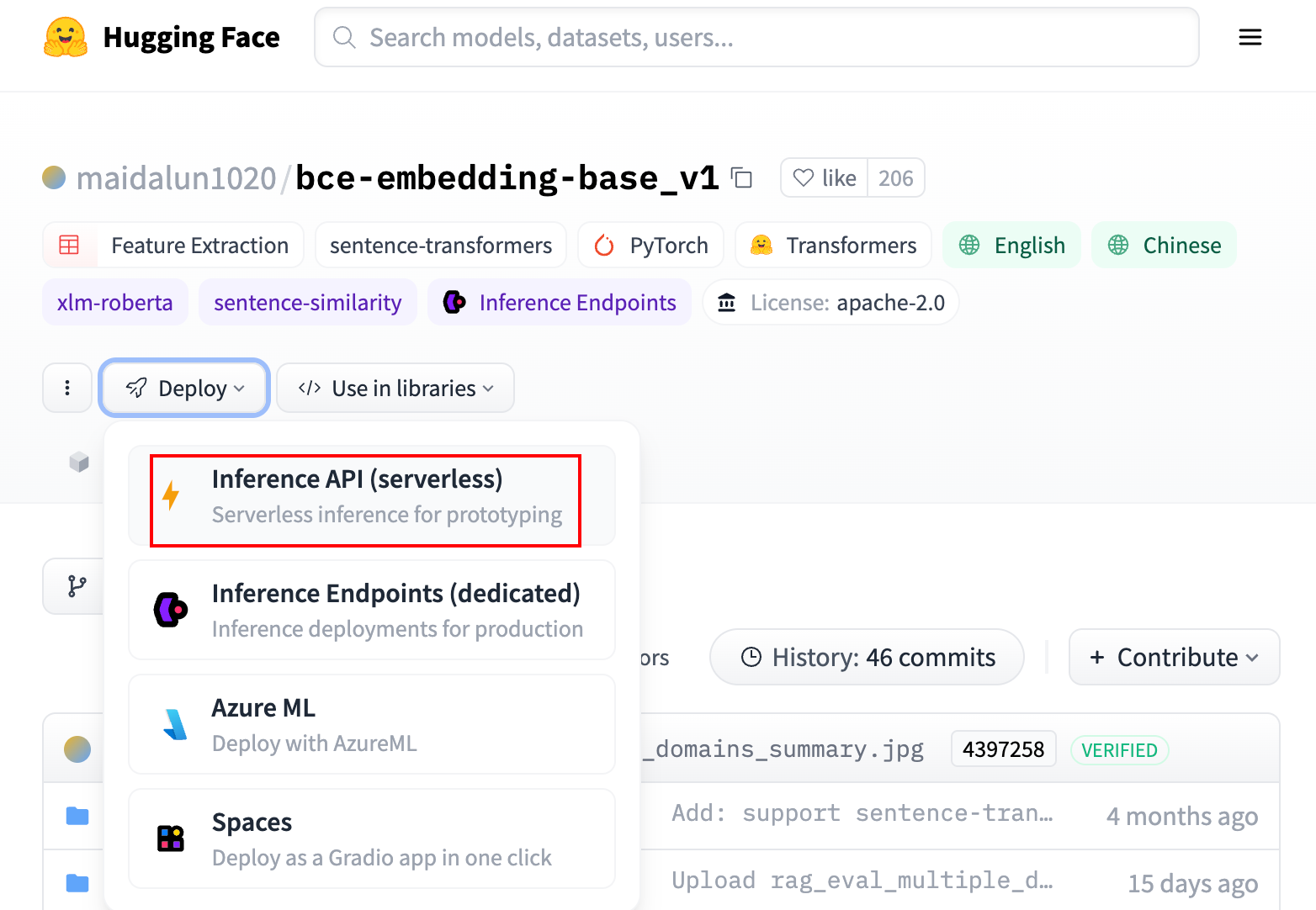前言
HuggingFace 是自然语言处理领域的开源软件库和平台,其收纳了众多最前沿的模型和数据集,并提供了 Serverless Inference API,用户可以轻松调用这些模型,甚至用于运行自己的私人模型。本教程将指导用户如何利用 Hugging Face API 零资源运行这些模型,并结合 LiteLLM 和 Flask 简化调用逻辑,以适配 OpenAI。
教程概要
- 介绍 Hugging Face Serverless API 的使用方法,包括如何调用嵌入模型、文本生成模型和对话模型。
- 通过 LiteLLM 转换 Hugging Face 模型为 OpenAI 格式。
- 使用 Flask 创建一个接口,转发请求并实现自定义逻辑。
Hugging Face
简介
参考文档: Hugging Face API Inference
Serverless Inference API 让用户通过简单的 HTTP 请求即可免费测试和评估超过 15 万个公开的机器学习模型,以及使用自己的私人模型。推理由 Hugging Face 提供的共享基础设施加速。
- 免费使用:推理 API 免费提供使用,并且有速率限制。需要用于生产环境的推理解决方案,可使用 Inference Endpoints 服务。
- 主要特点:
- 支持超过 15 万个 Transformers、Diffusers 或 Timm 模型。
- 内置集成 20 多个开源库,如 spaCy、SpeechBrain、Keras 等。
- 模型切换方便,通过切换模型 ID 即可。
- 支持多种任务,如分类、图像分割、语音识别、对话、摘要、翻译、问答、嵌入提取等。
- 基于 Intel Xeon Ice Lake 提供加速推理。
用户可通过 Inference Endpoints 标签 筛选支持 Inference API 的模型。

文生图模型
示例模型:stable-diffusion-xl-base-1.0
调用方式:
prompt="Imagine a delightful scene found in a children'\''s book. There'\''s a playful puppy with its adorable features exaggerated in classic cartoon style. Its fur is a soft golden color, with a pair of sparkling eyes full of curiosity. Its tail, bushy and wagging, is an embodiment of its joyful nature. The puppy is in a typical playful stance, a chew toy in its mouth and its tongue hanging out. The scene is set in a homely backyard with green grass and plenty colorful flowers, and a bright sun up in the sky, resulting in a warm, inviting atmosphere."curl https://api-inference.huggingface.co/models/stabilityai/stable-diffusion-xl-base-1.0 \-X POST \-d '{"inputs": "$prompt"}' \-H 'Content-Type: application/json' \-H "Authorization: Bearer $HF_TOKEN" \--output puppy.jpeg
返回二进制图片数据,输出到指定文件。
输出效果:

嵌入模型
以网易有道推出的 BCEmbedding 模型为例,先找到 Hugging Face 的地址:
- maidalun1020/bce-embedding-base_v1
调用方法:
curl https://api-inference.huggingface.co/models/maidalun1020/bce-embedding-base_v1 \-X POST \-d '{"inputs": "Today is a sunny day and I will get some ice cream."}' \-H 'Content-Type: application/json' \-H "Authorization: Bearer $HF_TOKEN"
返回结果:
[-0.0015705720288679004,0.008027488365769386,...]
还可用列表形式调用:
curl https://api-inference.huggingface.co/models/maidalun1020/bce-embedding-base_v1 \-X POST \-d '{"inputs": ["Today is a sunny day and I will get some ice cream.", ...]}' \-H 'Content-Type: application/json' \-H "Authorization: Bearer $HF_TOKEN"
文本生成模型
以 MetaAI 的 Llama3 为例:
- HuggingFace 地址:meta-llama/Meta-Llama-3-8B-Instruct
调用方式:
curl https://api-inference.huggingface.co/models/meta-llama/Meta-Llama-3-8B-Instruct \-X POST \-d '{"inputs": "hello"}' \-H 'Content-Type: application/json' \-H "Authorization: Bearer $HF_TOKEN"
返回结果:
[{"generated_text":"hello! i am a junior high school student, and i am really interested in history..."}]
LiteLLM
简介
LiteLLM 项目 为主流的模型服务提供统一的调用方式。功能包括:
- 标准化接口:调用超过 100 种 LLM 模型,提供统一的输入/输出格式。
- 接口转换:支持将输入翻译成提供商的文本生成、嵌入和图像生成端点。
- 多部署重试/后备机制:可以在多个部署(如 Azure/OpenAI)之间重试或切换。
- 预算和速率限制:可为项目、API 密钥或模型设置预算和速率限制。
- 跟踪开销:可监控项目花费,并设置预算限制。
安装
通过 pip 安装:
pip install litellm
如果希望将 LiteLLM 服务部署成类似 OneAPI 的形式,并带有 UI 管理界面,则用以下方式进行安装:
git clone https://github.com/BerriAI/litellm.git
cd litellm
pip install 'litellm[proxy]'
启动服务:
litellm
可参阅完整的参数文档:CLI Arguments
配置文件
为 litellm 添加下游模型并设置转发规则,参考文档:
- Proxy 配置
- 支持的模型类型。
配置文件中有五个主要设置:
| 参数名 | 描述 |
|---|---|
model_list | 服务器上支持的模型列表及其特定配置 |
router_settings | LiteLLM 路由设置,如 routing_strategy="least-busy" |
litellm_settings | LiteLLM 模块设置,如 litellm.drop_params=True、litellm.set_verbose=True、litellm.api_base |
general_settings | 服务器设置,如 master_key: sk-my_special_key |
environment_variables | 环境变量,如 REDIS_HOST、REDIS_PORT |
项目仓库下的 proxy_server_config.yaml 提供了完整的示例配置文件。以下示例用于配置 Hugging Face 模型:
model_list:- model_name: bce-embedding-base_v1litellm_params: model: huggingface/maidalun1020/bce-embedding-base_v1 # 自动路由到 Hugging Faceapi_key: hf_... # Hugging Face API 密钥- model_name: Meta-Llama-3-8B-Instructlitellm_params: model: huggingface/meta-llama/Meta-Llama-3-8B-Instructapi_key: hf_...general_settings: master_key: sk-1234 # 调用的密钥,也是管理员登录密码# 如果配置 UI 界面,需数据库支持store_model_in_db: True database_url: "postgresql://<user>:<password>@<host>:<port>/<dbname>" # [可选] 用于代理的数据库支持
参数说明:
master_key作为调用的密钥,也作为管理员的登录密码store_model_in_db保存在线的模型修改database_urlUI 界面的管理需要数据库支持
Docker 配置
如果希望避免手动配置 Python 环境和数据库,官方提供了 Docker 部署方式。文档:Docker 部署。
以下是个人经过调整并验证有效的 docker-compose.yaml:
version: "3.9"
services:db:image: postgres:latestcontainer_name: litellm_dbvolumes:- ./pgdata:/var/lib/postgresql/dataenv_file:- .envlitellm:build:context: .args:target: runtimeimage: ghcr.io/berriai/litellm:main-latestdepends_on:- dbports:- "4000:4000"volumes:- ./litellm-config.yaml:/app/config.yamlcommand: [ "--config", "/app/config.yaml", "--port", "4000", "--num_workers", "8", "--detailed_debug" ]env_file:- .env
.env 文件的内容:
# Postgres 配置
POSTGRES_USER=
POSTGRES_PASSWORD=
POSTGRES_DB=
# LiteLLM 配置
LITELLM_MASTER_KEY="" # 主密钥,用于代理服务器
UI_USERNAME="" # UI 界面的用户名
UI_PASSWORD="" # UI 界面的密码
STORE_MODEL_IN_DB='True'
# 默认端口 5432,用户名密码需与上面的 POSTGRES_USER 和 POSTGRES_PASSWORD 一致
DATABASE_URL="postgresql://<user>:<password>@<host>:<port>/<dbname>"
Flask
简介
HuggingFace 的文生图接口返回的是二进制图片数据,我们可以使用 Flask 结合 Nginx 代理,将结果以链接形式返回。
下面的代码段展示了如何实现这个功能,将数据保存在 /storage/dalle3/ 目录下,并通过 CDN 链接返回。
from flask import Flask, request, jsonify
import requests, os, io, uuid
from datetime import datetime
from PIL import Image
import jsonapp = Flask(__name__)
HF_TOKEN = "hf_xxx"
HF_MODEL_ID = "ehristoforu/dalle-3-xl-v2"
HUGGING_FACE_API_URL = f"https://api-inference.huggingface.co/models/{HF_MODEL_ID}"
IMAGE_SAVE_DIR = "/storage/dalle3/"
CDN_PREFIX = "https://cdn.example.com/dalle3"def prompt_revision(prompt):# 自定义规则,将用户的 Prompt 进行优化,对图像进行更细致的描述return promptdef generate_images(prompt):headers = {"Authorization" : f"Bearer {HF_TOKEN}"}response = requests.post(HUGGING_FACE_API_URL, headers=headers, json={"inputs": prompt})if response.status_code == 200:timestamp = datetime.now().strftime("%Y%m%d%H%M%S") # Generate timestamp stringimage_path = os.path.join(IMAGE_SAVE_DIR, f"{timestamp}_{uuid.uuid4()[:8]}.jpeg")image = Image.open(io.BytesIO(response.content))image.save(image_path, "JPEG")url = f"{CDN_PREFIX}/{os.path.basename(image_path)}"return urlelse:return None@app.route('/v1/images/generations', methods=['POST'])
def image_generation():# Get the raw dataraw_data = request.data# Decode the raw data into a stringdecoded_data = raw_data.decode('utf-8')data = json.loads(decoded_data)prompt = data.get("prompt", "")n = data.get("n", 1) # Number of images to generate, TODO: support multiple imagesif prompt:revised_prompt = prompt_revision(prompt)url = generate_images(revised_prompt)if url:return jsonify({"created": int(datetime.now().timestamp()),"revised_prompt": revised_prompt,"data": [{"url": url}],})else:return jsonify({"error": "Failed to generate images"}), 500else:return jsonify({"error": "No prompt provided"}), 400if __name__ == '__main__':app.run(host='0.0.0.0', port=8080)
将文件保存为 dalle3.py 并启动模型:
# pip install gunicorn
gunicorn -w 4 -b 127.0.0.1:8080 dalle3:app
接着我们可以通过 Nginx 配置返回的 CDN 链接,如下所示:
server {listen 443 ssl;server_name cdn.example.com;# SSL 证书配置location /dalle3/ {alias /storage/dalle3/;}
}
最后,通过 OpenAI 接口的方式调用:
curl https://cdn.example.com/v1/images/generations \-H "Content-Type: application/json" \-H "Authorization: Bearer $OPENAI_API_KEY" \-d '{"model": "dall-e-3", "prompt": "..."}'
以上,通过 Hugging Face、LiteLLM 和 Flask 来创建一个自定义接口,用于转发并处理各种模型的请求。



 | 九种进程间通讯方式速揽)

)






![YOLOv8的训练、验证、预测及导出[目标检测实践篇]](http://pic.xiahunao.cn/YOLOv8的训练、验证、预测及导出[目标检测实践篇])






